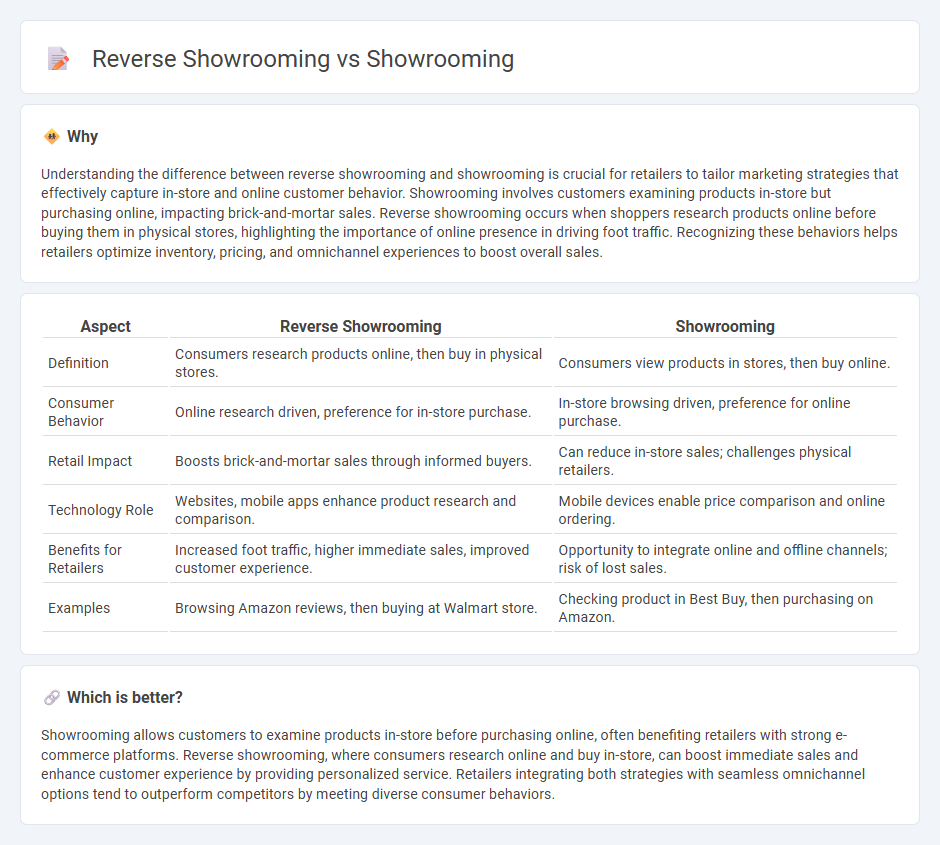
Reverse showrooming involves customers researching products online before visiting physical stores to make a purchase, contrasting with showrooming where shoppers examine items in-store but buy them online. Retailers face challenges balancing inventory and pricing strategies to accommodate both behaviors effectively. Explore more insights on how reversing the showrooming trend impacts retail sales and consumer engagement.
Why it is important
Understanding the difference between reverse showrooming and showrooming is crucial for retailers to tailor marketing strategies that effectively capture in-store and online customer behavior. Showrooming involves customers examining products in-store but purchasing online, impacting brick-and-mortar sales. Reverse showrooming occurs when shoppers research products online before buying them in physical stores, highlighting the importance of online presence in driving foot traffic. Recognizing these behaviors helps retailers optimize inventory, pricing, and omnichannel experiences to boost overall sales.
Comparison Table
| Aspect | Reverse Showrooming | Showrooming |
|---|---|---|
| Definition | Consumers research products online, then buy in physical stores. | Consumers view products in stores, then buy online. |
| Consumer Behavior | Online research driven, preference for in-store purchase. | In-store browsing driven, preference for online purchase. |
| Retail Impact | Boosts brick-and-mortar sales through informed buyers. | Can reduce in-store sales; challenges physical retailers. |
| Technology Role | Websites, mobile apps enhance product research and comparison. | Mobile devices enable price comparison and online ordering. |
| Benefits for Retailers | Increased foot traffic, higher immediate sales, improved customer experience. | Opportunity to integrate online and offline channels; risk of lost sales. |
| Examples | Browsing Amazon reviews, then buying at Walmart store. | Checking product in Best Buy, then purchasing on Amazon. |
Which is better?
Showrooming allows customers to examine products in-store before purchasing online, often benefiting retailers with strong e-commerce platforms. Reverse showrooming, where consumers research online and buy in-store, can boost immediate sales and enhance customer experience by providing personalized service. Retailers integrating both strategies with seamless omnichannel options tend to outperform competitors by meeting diverse consumer behaviors.
Connection
Reverse showrooming and showrooming are interconnected retail behaviors where consumers alternate between physical stores and online shopping to optimize purchasing decisions. Showrooming occurs when customers visit brick-and-mortar stores to examine products before buying them online at lower prices, while reverse showrooming involves researching products online and then purchasing them in-store to avoid shipping delays and enjoy immediate ownership. Both practices influence retailers to integrate omnichannel strategies, improve in-store experiences, and offer competitive pricing to capture customer engagement across platforms.
Key Terms
Omnichannel
Showrooming occurs when customers visit physical stores to examine products but complete purchases online, whereas reverse showrooming involves browsing online and buying in-store. Omnichannel strategies enhance customer experiences by integrating digital and physical touchpoints, enabling seamless transitions between channels and driving higher sales conversions. Explore how leveraging omnichannel retailing can optimize both showrooming behaviors and consumer engagement.
Price comparison
Showrooming involves consumers visiting physical stores to examine products before purchasing them online at lower prices, highlighting the importance of competitive online pricing strategies. Reverse showrooming occurs when shoppers research products online and then buy them in-store, emphasizing the need for retailers to match or beat online prices to capture sales. Explore key pricing strategies and techniques to optimize both showrooming and reverse showrooming in your retail business.
In-store experience
Showrooming involves customers visiting physical stores to examine products before purchasing them online, leveraging the tactile in-store experience but seeking better prices or convenience digitally. Reverse showrooming occurs when shoppers research products online first, then visit brick-and-mortar stores to complete their purchase, valuing immediate product access and personalized assistance. Explore more about how retailers can optimize in-store experiences to capture both showrooming and reverse showrooming customers effectively.
Source and External Links
Showrooming & Webrooming: What It Is, Benefits, How To (2024) - Showrooming is a shopping behavior where consumers visit stores to examine products but buy them online, often due to lower online prices, transforming physical stores into showrooms and encouraging retailers to adapt by focusing on customer experience and ship-to-customer fulfillment.
Showrooming - Wikipedia - Showrooming involves inspecting merchandise in a physical store and purchasing it online, sometimes at lower prices, with the reverse behavior called webrooming, where customers research online and buy offline; this trend affects retailers' profits and has contributed to retail challenges like the collapse of some chains.
Showrooming - Salsify - Showrooming describes consumers physically assessing products in brick-and-mortar stores before buying online, especially useful for items like clothing or expensive products, prompting some retailers to embrace the trend by integrating ecommerce options and guiding customers through showrooming with perks like discounts or free shipping.
 dowidth.com
dowidth.com